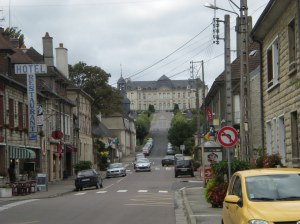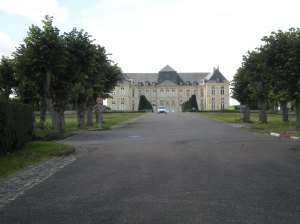Napoleon’s Campaign in France 1814 – Part 2
The Battle of Brienne 29 January 1814
 Brienne is the ideal place to start the 1814 tour. Not only is it the town where Napoleon went to school, but it’s also the first major field engagement of the campaign. It’s a pleasant, rather sleepy town that boasts a fine chateau (now a hospital) that featured in the battle. There is also a quirky museum with hand-made exhibits that nevertheless comprehensively describe the entire campaign. Cossack lances lean against the display cabinets and the walls, as if their owners have just temporarily abandoned them while they’ve popped out for a little light plundering. There’s also a Napoleonic sabre that until recently was used for the local sport of what I can only describe as ‘goose-whacking’ – beheading a live goose hanging upside down from tree while blindfolded. You really couldn’t make this stuff up. The whole museum is housed in the classrooms of the military academy where the young Buonaparte was a pupil, and includes such trivia as his record of the menus in the refectory, which seemed to include a lot of beetroot!
Brienne is the ideal place to start the 1814 tour. Not only is it the town where Napoleon went to school, but it’s also the first major field engagement of the campaign. It’s a pleasant, rather sleepy town that boasts a fine chateau (now a hospital) that featured in the battle. There is also a quirky museum with hand-made exhibits that nevertheless comprehensively describe the entire campaign. Cossack lances lean against the display cabinets and the walls, as if their owners have just temporarily abandoned them while they’ve popped out for a little light plundering. There’s also a Napoleonic sabre that until recently was used for the local sport of what I can only describe as ‘goose-whacking’ – beheading a live goose hanging upside down from tree while blindfolded. You really couldn’t make this stuff up. The whole museum is housed in the classrooms of the military academy where the young Buonaparte was a pupil, and includes such trivia as his record of the menus in the refectory, which seemed to include a lot of beetroot!
 In the battle itself, Blücher, the aging Prussian firebrand general and notorious francophobe had become separated from Yorck’s corps and the Army of Bohemia, and was concentrated at Brienne with 40,000 Prussian and Russian troops. His headquarters was in the chateau, where his troops had smashed a collection of specimen jars, owned by the Marquis who was something of a scientist. In the absence of Schnapps, they had been drinking the surgical alcohol that preserved the jars’ contents. Needless to say this did not improve their performance, whatever it may have done for their courage.
In the battle itself, Blücher, the aging Prussian firebrand general and notorious francophobe had become separated from Yorck’s corps and the Army of Bohemia, and was concentrated at Brienne with 40,000 Prussian and Russian troops. His headquarters was in the chateau, where his troops had smashed a collection of specimen jars, owned by the Marquis who was something of a scientist. In the absence of Schnapps, they had been drinking the surgical alcohol that preserved the jars’ contents. Needless to say this did not improve their performance, whatever it may have done for their courage.
The cavalry of Lefebvre-Desnouettes and the infantry of Victor, known as ‘Marie-Louises’ since they were as smooth-cheeked as the Empress herself, by virtue of their tender age, swept across the plain from the East and through the town, forcing the Coalition troops out by nightfall. Losses were by no means light: some 3,000 French dead and 4,000 of their enemy lay strewn across the fields and town, the whole macabre scene being lit by the glow of the fires raging through the town and chateau.
